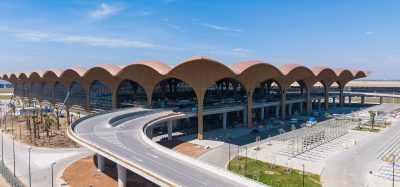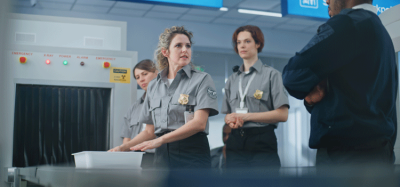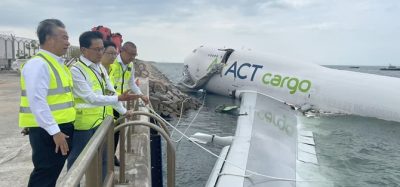Passenger screening checkpoints: Fortess security or business asset?
Posted: 1 June 2012 | Norman Shanks, Professor in Aviation Security, Coventry University | No comments yet
One of the universal truths about modern air travel is that nobody likes the passenger pre-board screening process. Whilst pass – engers questioned immediately after a successful or foiled terrorist attack will readily say that they accept the pre-board screening process as it is there to ensure their safety, opinion changes after a few months when their memory, or more often media coverage of these events, fades into the background.
Pre-board screening in one form or another has been a feature of air travel for the past 60 or so years, but it was really in the early 1970s that the process that we are familiar with today began to affect all air travel. It grew out of the spate of middle eastern inspired terrorist hijackings following high-profile incidents, such as Dawson’s Field in Jordan in 1970, when the requirement for screening passengers (for hijack weapons) was brought under ICAO’s remit.
Passengers are screened by metal detection equipment, normally walk-through metal detectors, with a physical search or ‘pat-down’ for those passengers who cause the archway to alarm. A modern variation of this in some locations such as Europe, is for a percentage of those passengers who have not caused the system to alarm to also be subject to a physical search in recognition that not all weapons are metallic and screening passengers relies heavily on equipment designed to detect these metallic weapons.
One of the universal truths about modern air travel is that nobody likes the passenger pre-board screening process. Whilst pass – engers questioned immediately after a successful or foiled terrorist attack will readily say that they accept the pre-board screening process as it is there to ensure their safety, opinion changes after a few months when their memory, or more often media coverage of these events, fades into the background.
Pre-board screening in one form or another has been a feature of air travel for the past 60 or so years, but it was really in the early 1970s that the process that we are familiar with today began to affect all air travel. It grew out of the spate of middle eastern inspired terrorist hijackings following high-profile incidents, such as Dawson’s Field in Jordan in 1970, when the requirement for screening passengers (for hijack weapons) was brought under ICAO’s remit.
Passengers are screened by metal detection equipment, normally walk-through metal detectors, with a physical search or ‘pat-down’ for those passengers who cause the archway to alarm. A modern variation of this in some locations such as Europe, is for a percentage of those passengers who have not caused the system to alarm to also be subject to a physical search in recognition that not all weapons are metallic and screening passengers relies heavily on equipment designed to detect these metallic weapons.
The reality is that the process for pre-board screening at the majority of international airports has remained rather static over the past 40 or so years with only minor changes to the technology deployed. Archway weapon detectors still only detect metallic threats and the x-ray technology used at the majority of airports still focuses on the detection of hijack weapons, despite the risk of an attack by bombs in carry-on baggage.
If we review the major terrorist attacks over the previous two decades, it is clear that there have been differing results. Whereas the response to the PA 103 incident in 1988 ultimately led to a significant improvement in checked baggage screening using technology that has a very high probability of detecting explosive devices, the incidents arising from, and after the terrorist attacks of September 11, 2001, has been rather more piecemeal.
Undoubtedly the most welcome change arising from the 9/11 incidents was that the passenger pre-boarding screening process at U.S. airports was dramatically improved from a very poor standard to a screening regime that matched the best of the rest of the world (mainly the UK and Europe with a few other notable locations, such as Hong Kong International Airport).
The reaction to the Richard Reid shoe bomb attempt in 2001 resulted in the requirement for passengers to remove their shoes for separate screening by x-ray, this practice varies even today from locations where all shoes must be removed, to only a representative sample at other locations.
By contrast, the failed ‘liquids bomb’ incident in the UK in 2006, led to a much more dramatic change for passengers with restrictions on the quantity of Liquids, Aerosols and Gels (LAGs) that can be carried in their carry-on baggage. This restriction (recommended by ICAO in a state letter AS /11-06/100, 1 December 2006) is almost universally followed and has led to an industry drive to improve screening technology to detect improvised liquid explosives.
In fact, such technology has been available for many years in the form of dedicated bottle scanners but the downside of this technology is that individual bottles have to be screened separately which introduces an additional element to an already time consuming process. It is no wonder that the alternative of restricting the carriage of LAGs in passenger carry-on baggage was more readily adopted by airports and regulators alike. For many months this had a dramatic impact on airport retail sales of duty and tax-free items until the industry itself (this time the duty and tax-free retailers) came up with the solution which allows passengers transferring at other international airports to carry these items in Security Tamper Evident Bags (STEBs) thereby enabling the security screeners to recognise that these items are from a safe, pre-screened source.
The next major incident, was the ‘underpants bomber’, Umar Farouk Abdulmutallab on December 25, 2009, who successfully passed through at least two passenger screening checkpoints (point of origin and the transfer point at Schiphol Airport) without detection of the device he was wearing around his groin under his trousers. The reaction to this incident, which in reality was as much an intelligence failure as a failure of the global screening protocols, was the hasty introduction of whole-body imaging systems using either x-ray or millimetre wave technology. The unseemly haste, principally by the U.S. authorities with the widespread deployment of such systems before they were actually proven to be a wholly effective countermeasure, appears to many to be more of a political expedient than a significant enhancement of the passenger checkpoint process.
Recent reports attributed to the Director of Homeland Security and Justice Issues at the U.S. Government Accountability Office (GAO) in testimony to a House Committee on Oversight and Government Reform hearing, told the committee it found some scanners were used less than five per cent of the days during a review from March 2010 through February 2011. In addition, some of the machines had been used less than 30 per cent of the time since they were installed. The Director went on to say: “The limited use of some of these machines may indicate that there was not a clear need for them at the time they were required at the locations in which they were deployed.” This will only reinforce the views held by many security professionals that this was a political expedient and not a considered response to the threat of improvised explosive devices being carried under passengers’ clothing, giving rise to the term, ‘security theatre’. While a number of other countries introduced this technology there are many more who appear to be steadfastly opposed and it is unlikely that body-scanners will become an industry standard in the shortto near-term.
There have also been incidents in the UK where passengers who objected to be screened by whole-body imagers were refused the right to fly. The UK government introduced a rather draconian policy of refusing passengers an alternative option of screening, in effect if they refused to submit, they would not be allowed to board the aircraft. This would make an interesting case study if any of those passengers affected chose to take their case to the European Court arguing that this regulation infringed their human rights, particularly as it is not a view supported by other EU States.
This highlights perhaps one of the key problems with many passenger checkpoints; passengers are presumed to be guilty, or rather it feels so to many by the often off-hand and unfriendly manner in which they are ‘herded’ through the security coral. I fully accept this is a very wide generalisation but sadly human nature being what it is, one experience of a badly managed checkpoint supersedes the many times that a friendly smile or comment is made to the passenger rather than the security staff chatting amongst themselves and demonstrating little regard for the values of the passenger.
That said there is hope on the horizon. I refer of course to the IATA ‘Checkpoint Of The Future’ which has as its genesis, industry trials during 2003 of a consortium of several equipment manufacturers together with an independent U.S. based test organisation, the National Safe Skies Alliance and an independent security consultant, conducted a series of trials with the latest (as at 2003) developments of their security technologies.
Several years after this, the IATA ‘COTF’ was born, at least in concept form. Much has been reported on this concept in the past year or so, therefore it’s sufficient to say that the intent behind this concept is to enhance security while providing a better experience for the passenger, a key element that is sadly missing in many checkpoints today. The underlying concept is to look for bad people not just bad objects and it predicts the ‘end of the road for one size fits all screening’. The concept relies heavily on the use of passenger data from a range of sources such as, advanced passenger information, airline frequent flyer databases, and other less obvious means available only to government entities involved in ‘homeland’ security, and merging this information with a sound behavioural detection programme, often erroneously called profiling.
This enables passengers to be pre-screened according to a risk matrix and selected for one of three checkpoint lanes: ‘baseline’ for ‘known travellers’; a slightly elevated lane for those that fall into the ‘normal’ category; and an ‘enhanced’ lane for the passengers whom little is known about or those selected by behaviour detection programmes, together with a small number randomly selected (in line with current philosophy that unpredictability to the standard ‘norm’ is a sound security practice as it cannot be pre-planned for).
IATA openly acknowledges that it will take between five and seven years for all of the necessary components to be readily available for this new checkpoint experience. History tells us however, that it is more likely to be in the range of 10-15 years before we see this is as standard practice at the majority of international airports.
So, what can we do today? Firstly, take a lead from the best of the hospitality industry (for in effect this is airports’ core business) treat passengers with courtesy and respect. Travel, even for regular air travellers can cause considerable stress and being treated with, all too often, complete dis-regard for their role as a valued customer is unprofessional and essentially rude. It demeans both the passenger and screener alike, and ignores the basic tenet that passengers as well as security staff deserve to be treated with courtesy. Much of this is driven by out of date checkpoint layouts that do little to relieve the pressure from the endless queues that staff and passengers are faced with at peak periods.
There are signs of change at a small number of airports where some new thinking has been given to the process of screening passengers. The new layout at Manchester International Airport in the UK is one such enlightened area; while not perfect it is at least a very big move in the right direction.
Future checkpoints will inevitably rely heavily on technology with automatic threat detection capability. Indeed we are observing the birth of this with the latest developments on whole-body imaging systems designed to reduce the concerns that passengers have over their ‘naked images’ being viewed by security screeners.
Automatic threat recognition already exists in technology used for screening passenger checked bags, yet we typically do not deploy this type of technology for cabin baggage screening. Why you might ask? The answer is simple economics; the smaller versions suitable for use at passenger screening checkpoints are significantly more expensive than the conventional x-rays used at the majority of airport checkpoints, but there is a major difference, these new systems can detect a range of liquid as well as conventional explosives, whereas the x-rays used at most passenger screening checkpoints today, cannot. We continue to rely on the screener identifying not only conventional hijack weapons but much more complex cleverly concealed improvised explosive devices. In effect, we expect the screener to perform the near impossible and then complain loudly when a terrorist or a ‘mystery tester’ manages to smuggle a device through the checkpoint. The solution is obvious; upgrade the technology to match the risk.
This clearly cannot be achieved overnight at all locations for many years but at some point, a small number of existing systems could be replaced with more appropriate technology to provide options at the checkpoint for screening selected groups of passengers to a higher degree, whilst maintaining a baseline for the vast majority of passengers who represent low or zero risk. The number of high-technology lanes will clearly vary depending on the size and scale of the airport but it is not unreasonable to require even small to mid-size airports to have at least one lane that is suitable for screening passengers who represent higher risks. Selection of these passengers can be by reasoned selection through advanced information and intelligence and through behavioural detection programmes conducted by staff trained in behaviour detection techniques, or suspicious behaviour observed through the increasing use of CCTV with embedded video analytics software.
Until such time as the IATA checkpoint of the future can be fully realised it is entirely reasonable to expect that at least part of the concept could be put in place today. We should dedicate the existing checkpoint lanes for passengers who are considered low or minimal risk either through programmes such as the TSA’s new passenger pre-screening, Pre✓™ which, they claim, “is an intelligence-driven, risk-based approach to enhance aviation security by placing more focus on pre-screening individuals who volunteer to participate in order to expedite the travel experience”, or similar. The ‘baseline’ lanes should be supplemented with an ‘advanced technology’ lane for the small percentage of passengers who represent a greater risk.
To maximise the use of the enhanced security lane and add a degree of unpredictability for passengers on a reconnaissance trip, individual passengers or groups, who otherwise might be considered low risk, could be selected to the Enhanced Security Lane so that those looking for weaknesses in the security checkpoint might otherwise be convinced that the prospect of being able to get through the checkpoint with a weapon or device is now much more difficult and hopefully, will give them incentive to go somewhere else.
It is tempting to say that all screening checkpoints should be completely re-designed as a matter of urgency but we have to remember that airports are commercial businesses and security is just one element, although a key one, of the business and for any business to succeed it is essential that all elements deliver a good return on investment, even if that is simply helping to retain repeat business by providing an efficient, effective and courteous security and customer service.
About the author
Norman Shanks is founder and Principal Partner of NSAI, a consultancy company specialising in aviation security and airport management services. He is a visiting Professor in Aviation Security at Coventry University (UK), an adjunct Associate Professor at Edith Cowan University, Western Australia, and a Fellow of the Security Institute. Norman is recognised internationally as one of the world’s foremost experts in aviation security. His aviation career spans over 40 years and covers a wide range of airport activities and latterly consultancy for the aviation industry.
Join our free webinar: Transforming Airport Security – Innovation, Impact, and the Passenger Experience
The landscape of airport security is undergoing a profound transformation, driven by evolving threats, technology, and passenger expectations. This webinar focuses on how AtkinsRéalis has been transforming security processes at some of the world’s busiest airports with smarter, more adaptive solutions.
Date: 4 Nov | Time: 14:00 GMT
REGISTER NOW TO SECURE YOUR SPOT
Can’t attend live? No worries – register to receive the recording post-event.


















